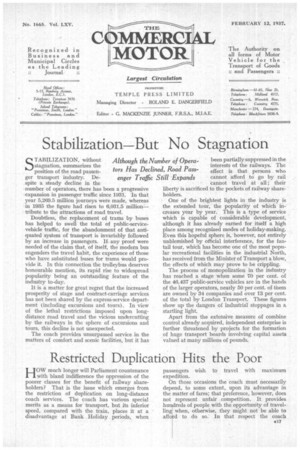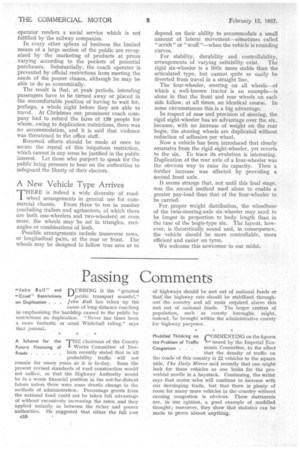Restricted Duplication nits the Poor H OW much longer wi ll Parliament
Page 67

Page 68

If you've noticed an error in this article please click here to report it so we can fix it.
countenance with bland indifference the oppression of the poorer classes for the benefit of railway shareholders? That is the issue which emerges from the restriction of duplication on long-distance coach services. The coach has various special merits as a means for transport, but its inferior speed, compared with the train, places it at a disadvantage at Bank Holiday periods, when passengers wish to travel with maximum expedition.
On those occasions the coach must necessarily depend, to some extent, upon its advantage in the matter of fares; that preference, however, does not represent unfair competition. It provides hu dreds of people with the opportunity of travel]in when, otherwise, they might not be able to aft o d to do so. In that respect the coach operator renders a social service which is not fulfilled by the railway companies.
In every other sphere of business the limited means of a large section of the public are recognized by the marketing of products at prices varying according to the pockets of potential purchasers. Substantially, the coach operator is prevented by official restrictions from meeting the needs of the poorer classes, although he may be able to do so economically.
The result is that, at peak periods, intending passengers have to be turned away or placed in the uncomfortable position of having to wait for, perhaps, a whole night before they are able to travel. At Christmas one prominent coach company had to refund the fazes of 139 people for whom, owing to duplication restrictions, there was no accommodation, and it is said that violence was threatened to the office staff.
Renewed efforts should be made at once to secure the repeal of this iniquitous restriction, which cannot in any sense be justified in the public interest. Let those who purport to speak for the public bring pressure to bear on the authorities to safeguard the liberty of their electors.
A New Vehicle Type Arrives
THERE is indeed a wide diversity of road .I. wheel arrangements in general use for commercial chassis. From three to ten in number (excluding trailers and agrimotors, of which there are both one-wheelers and two-wheelers) or even more, the wheels may be set in triangles, rectangles or combinations of both.
Possible arrangements include transverse rows, or longitudinal pairs, at the rear or front. The wheels may be designed to follow true arcs or to depend on their ability to accommodate a small amount of lateral Movement—sciinetimes called "scrub" or "scuff "—when the vehicle is rounding curves.
For stability, durability and controllability, arrangements of varying suitability exist. The rigid six-wheeler is a little more stable than the articulated type, but cannot quite so easily be diverted from travel in a straight line.
The four-wheeler, steering on all wheels—of which a well-known tractor is an example—is alone in that the front and rear wheels on each side follow, at all times, an identical course. In some circumstances this is a big advantage.
In respect of ease and precision of steering, the rigid eight-wheeler has an advantage over the six, because, with no increase of weight on the rear bogie, the steering wheels are duplicated without reduction of adhesion per wheel.
Now a vehicle has been introduced that clearly emanates from the rigid eight-wheeler, yet reverts to the six. To trace its evolution is interesting. Duplication of the rear axle of a four-wheeler was the obvious way to raise its capacity. Then a further increase was effected by providing a second front axle.
It seems strange that, not until this final stage, was the second method used alone to enable a greater pay-load than that of the four-wheeler to be carried.
• For, proper weight distribution, the wheelbase of the twin-steering-axle six-wheeler may need to be longer in proportion to body length than in the base of the bogie-type six. The layout, however, is theoretically sound and, in consequence, the vehicle should be more controllable, more efficient and easier on tyres.
We welcome this newcomer to our midst.




























































































































































